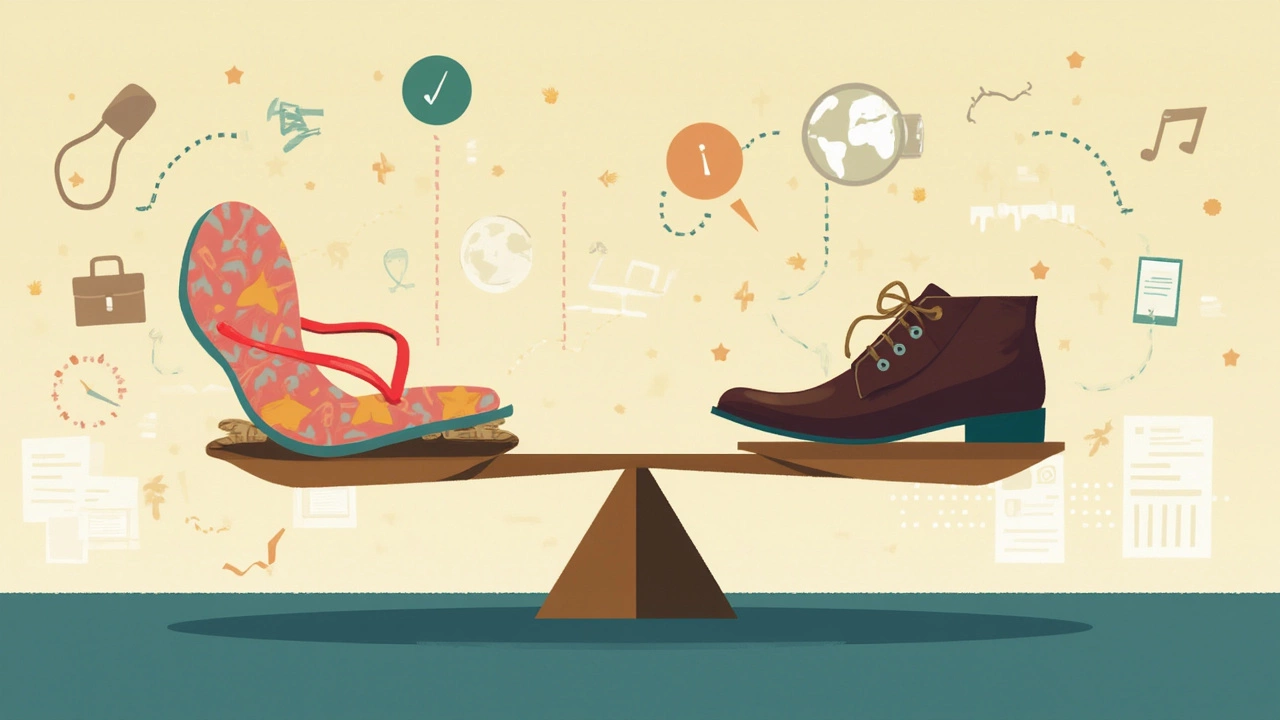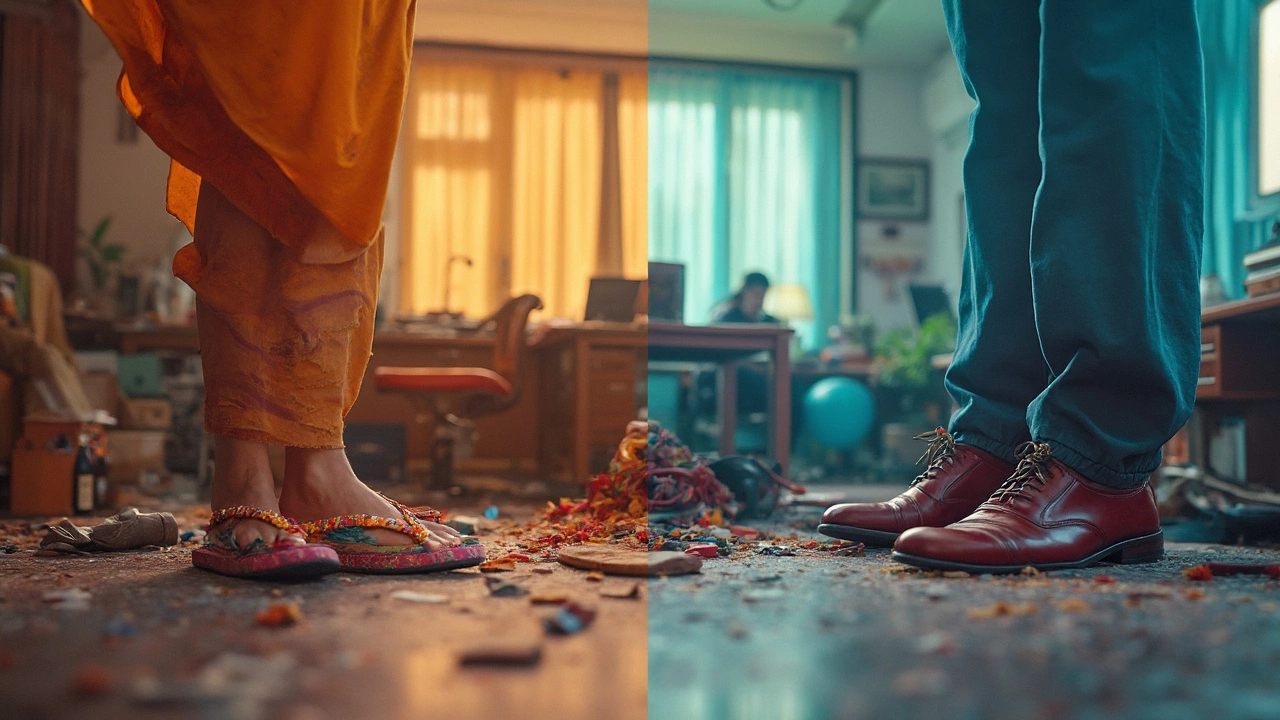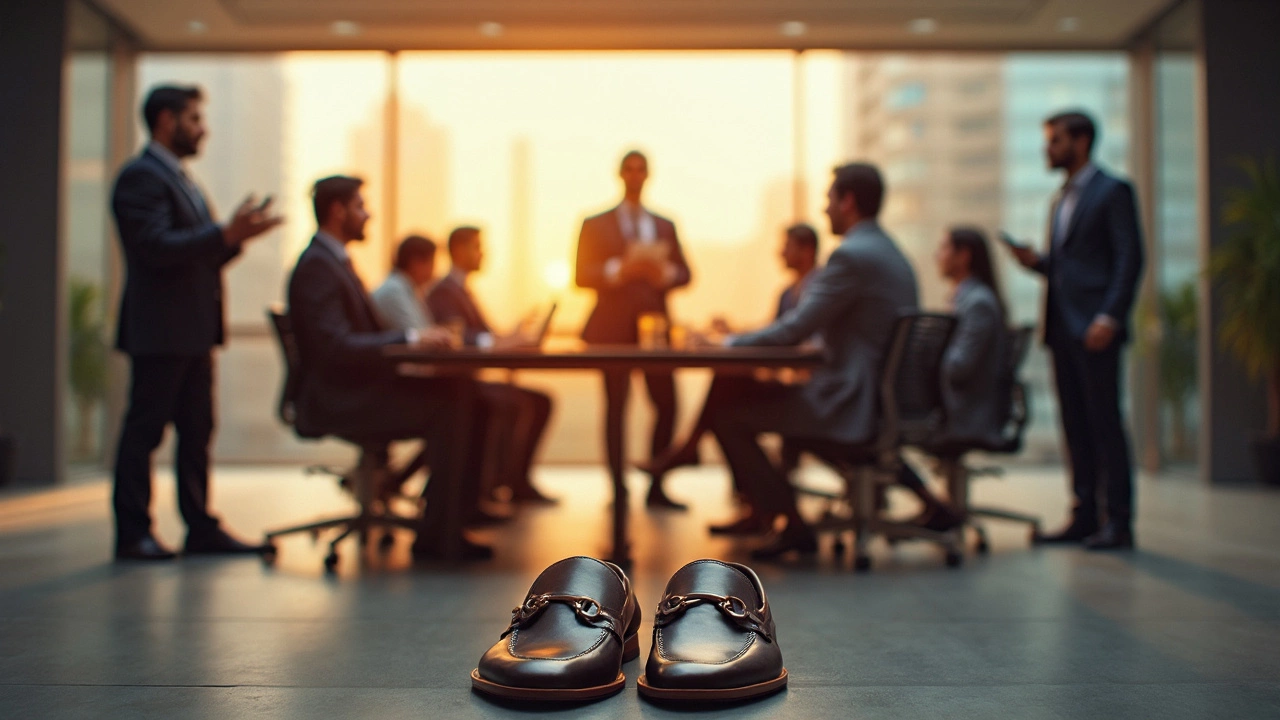Ever considered why flip flops are seen as a no-go at work? They might be your best pals during summer days or at the beach, but take them to the office, and you'll probably get a few raised eyebrows. It's not just about toe exposure; there are genuine reasons behind this unofficial rule.
For starters, let's talk safety. Flip flops offer minimal protection, which means they're not the best choice if you want to keep your toes intact around heavy office equipment or in crowded spaces. One misstep, and ouch! That's not the kind of attention anyone wants.
But it's more than just about safety. Office dress codes often insist on a certain level of formality. Flip flops tend to scream "casual," which can undermine a professional appearance. If you think about it, shoes do play a surprising role in first impressions and company culture.
- Safety First: The Risk with Flip Flops
- Understanding Workplace Dress Codes
- The Impact of Footwear on Professional Image
- Alternatives to Flip Flops for the Office
- How the Right Shoes Can Boost Your Career
Safety First: The Risk with Flip Flops
When it comes to the office, safety is no joke. Flip flops might be comfy for a stroll on the boardwalk, but slip them on in the office, and you're playing a risky game. These casual shoes simply don't give the foot protection needed around typical work hazards.
Trip and Fall Hazards
Let's start with tripping. Flip flops aren't exactly known for their secure grip on your feet. One sudden move, and they're slipping off. In a bustling office, that's the perfect setup for a stumble. Even worse, if you have to take a few fast steps, those loose soles might trip you up.
Minimal Foot Protection
Then there's the matter of protection. At your desk, you might feel out of danger, but workplaces often have unexpected hazards. From dropped office supplies to rolling chairs, feet don't get much shelter in flip flops. Imagine a stapler or, heaven forbid, a coffee pot going rogue—those toes would be in trouble.
Impact on Health
It’s not just external dangers; the shoes themselves can be a problem. Without arch support, flip flops can actually cause foot pain and long-term issues like plantar fasciitis, which is just a fancy name for heel pain that won't quit. Nobody wants chronic aches coming from everyday footwear choices.
Safety folks in many places are particular about these risks. Here’s a quick look at injury likelihood when wearing flip flops versus proper work shoes:
| Footwear Type | Injury Likelihood |
|---|---|
| Flip Flops | High |
| Enclosed Shoes | Low |
While styles come and go, it’s more about sticking to safe options in the office. For safety's sake, keep those work shoes practical and protective to avoid unnecessary scrapes or accidents.
Understanding Workplace Dress Codes
Ever wonder why offices have dress codes? They're more than just guidelines for what to wear; they reflect the company culture and public image. Whether it's casual Fridays or strictly business suits every day, these expectations are there to create consistency and professionalism among employees. And, as you might guess, flip flops don't usually make the cut.
Most offices aim for a certain level of decorum, and footwear is a big part of it. Think of dress codes as part of the unspoken agreement between employers and employees, ensuring everyone presents themselves appropriately, especially in client-facing roles. Wearing the right shoes, like dress shoes or clean sneakers, helps maintain a polished appearance.
The Spectrum of Dress Codes
Dress codes can range from very formal to super relaxed. Here's a quick rundown:
- Business Formal: Think high-level meetings or corporate settings. Typically involves suits and formal footwear like oxfords or loafers.
- Business Casual: A notch down from formal with chinos, button-down shirts, and clean leather shoes.
- Casual: Here you can typically wear jeans, polos, and sneakers. But, even in casual settings, flip flops often remain off-limits.
Interestingly, a study showed that nearly 71% of adults feel that dressing appropriately affects their respect in the workplace. Dress codes, therefore, aren’t just about what you wear; they influence how you're perceived by others, including colleagues and clients.
Why Flip Flops Don’t Fit the Code
Aside from being too casual, flip flops can often give the impression of being unkempt or unprofessional. They're more suited for leisure activities, not for making the right impression at the office. Plus, flip flops can be noisy, which might disrupt a quiet workspace—definitely not the vibe most offices aim for.
In short, understanding your company's dress code requirements is key to blending in seamlessly and maintaining a good professional image. The next time you're stashing flip flops in your bag, think twice about sliding them on when heading into the office.

The Impact of Footwear on Professional Image
Think shoes don't matter when you're in an office setting? Think again. The kind of shoes you wear plays a big part in how colleagues perceive you. We're talking about the signal you send by choosing shoes that scream 'beach day' over 'team player.'
In many workplaces, presentation is key. Even if you're wearing a sharp suit, pairing it with flip flops can send a mixed message. Not only does it look like you're not serious about your role, but it can also give the impression that you lack attention to detail.
Why does this matter? Because your appearance can affect your career growth. When all else is equal, the person who presents themselves more professionally is likely to get the nod in situations like promotions or key assignments.
How Others See You
Dress for the job you want, not the job you have. We've all heard it before, and it holds water. Shoes like flip flops can undermine your authority, especially in a corporate setting. Your attire—including your footwear—acts as a visual resume. If you're not willing to put in the effort with something as simple as what goes on your feet, what else might you cut corners on?
Creating the Ideal First Impression
First impressions are lasting, and footwear is a crucial part of that equation. When meeting clients or new team members, shoes that are neat and formal are part of a broader picture of professionalism. Studies suggest people often form an opinion about you within the first 30 seconds of meeting you, and most of that is visual.
| Shoe Type | First Impression |
|---|---|
| Dress Shoes | Professional, diligent |
| Flat Shoes | Comfort-oriented, approachable |
| Flip Flops | Casual, laid-back |
So, while flip flops have their place, it’s not usually in the office. Opt for shoes that tell people you mean business, literally and figuratively. Stick to this rule, and watch how it shifts the way people respond to you in the workplace.
Alternatives to Flip Flops for the Office
Thinking about what you should swap your flip flops with for a day at work? You're in luck. There's a whole world of stylish yet office-appropriate footwear that can keep you comfortable and looking sharp.
Loafers
Loafers are a great pick for both men and women. They're easy to slip on and off, just like flip flops, but they offer way more support and protection for your feet. Choose leather for that polished look or go for a suede version if you're feeling a bit adventurous. What makes loafers stand out is their versatility; they match well with almost anything in your workplace wardrobe.
Ballet Flats
For the ladies, ballet flats are a must-have. They provide a bit more coverage than open-toed shoes and are considered a suitable choice for most office settings. Whether you're sporting trousers, a dress, or a skirt, ballet flats complete any outfit without sacrificing comfort. Plus, there are endless styles and colors to fit your personal taste.
Oxfords
If you're aiming for a classic and clean vibe, Oxfords might be your answer. Known for their formal appeal, these shoes lend a smart look to both men's and women's outfits. Pair them with tailored trousers or a skirt, and you're ready to impress those around you in your next meeting.
Closed-Toe Sandals
Want to keep it breezy yet professional? Closed-toe sandals might be your best bet. They combine the comfort of sandals with the professionalism of work shoes, making them suitable for a more relaxed office atmosphere. Look for designs that offer proper arch support so you're not trading style for foot pain.
Sneakers
Yes, sneakers can work in an office setting! Many workplaces with a casual approach accept sneakers, especially classic or minimalist designs. They're great for days when you might be darting between meetings or if your job sometimes has you on your feet. Just make sure they’re clean, simple, and add to your overall professional look.
Equipping yourself with the right work shoes can really enhance not just your appearance, but your confidence at work. After all, comfortable feet mean less distraction and more focus on what truly matters.

How the Right Shoes Can Boost Your Career
Believe it or not, the work shoes you choose can play a pivotal role in your professional journey. It's not just about keeping up appearances either. The right footwear can enhance your comfort, confidence, and even your standing with bosses and colleagues.
Comfort Equals Productivity
First up, comfort matters. When you're on your feet all day, or even just trucking between meeting rooms, cushy and supportive shoes can make all the difference. Happy feet can lead to a clear mind, which naturally boosts your productivity and creativity.
Confidence in Every Step
Looking sharp isn’t purely vanity. When you know you look good, you feel good—and that translates to better work performance. Strutting into a meeting with a well-chosen pair of shoes can give you that extra bit of self-assurance to nail that presentation or close that deal.
Impressing the Right People
In many workplaces, appearances count. The right pair of shoes can show attention to detail and respect for the company culture. Whether it's your first day or a big promotion on the horizon, nailing the look can influence perceptions in your favor.
Stepping Up the Career Ladder
Consider the promotion aspect. Companies often look for employees who exude confidence and professionalism, which the right attire—including those work shoes—can portray. It's a subtle yet vital part of personal branding.
As a fun fact: A survey by the National Association of Professional Outfitters showed that 80% of employees believe wearing professional attire, including shoes, had a positive impact on workplace success.
Choosing the Perfect Pair
- Consider arch support: It matters more than you'd think over a full day's work.
- Select neutral colors: They match better and look more sophisticated.
- Focus on material: Leather isn’t just stylish; it's durable and ages well.
- Find the fit: Like a handshake, your shoes should be firm yet comfortable.
It's worth taking a good look at your work shoes. They’re one small part of a bigger career picture. So, lace up, buckle down, and step confidently into your future.
